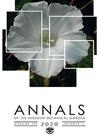New and Repeating Tipping Points: The Interplay of Fire, Climate Change, and Deforestation in Neotropical Ecosystems1
IF 1.1
3区 生物学
Q3 PLANT SCIENCES
引用次数: 4
Abstract
Abstract A 370,000-year paleoecological history of fire spanning four glacial cycles provides evidence of plant migration in response to Andean climate change. Charcoal, an indicator of fire, is only occasionally observed in this record, whereas it is ubiquitous in Holocene-aged Andean records. Fire is a transformative agent in Amazonian and Andean vegetation but is shown to be rare in nature. As humans promote fire, fire-free areas become microrefugia for fire-sensitive species. A distinction is drawn between microrefugia resulting from fire-free zones and those caused by unusual climatic conditions. The importance of this distinction lies in the lack of warmer-than-modern microrefugia aiding upslope migration in response to warming, whereas fire-free microrefugia support tree species above modern tree line or in areas of Amazonia least used by humans. The synergy between fire, deforestation, and climate change could promote a state-change in the ecosystem, one where new microrefugia would be needed to maintain biodiversity. Past tipping points are identified to have occurred within ca. 1°C–1.5°C of modern conditions. The recent climatic instability in both Amazonia and the Andes is viewed in the context of ecological flickering, while the drought-induced and fire-induced tree mortality are aspects of critical slowing down; both possibly portending an imminent tipping point.新的和重复的引爆点:新热带生态系统中火灾、气候变化和森林砍伐的相互作用1
摘要跨越四个冰川周期的37万年火灾古生态史为安第斯气候变化带来的植物迁移提供了证据。木炭是火灾的标志,在这一记录中只是偶尔观察到,而在全新世的安第斯记录中却随处可见。火灾是亚马逊和安第斯植被的一种变革因素,但在自然界中却很罕见。随着人类促进火灾,无火灾区域成为火灾敏感物种的微型避难所。对由无火区引起的微型避难所和由异常气候条件引起的微型避难区进行了区分。这种区别的重要性在于,没有比现代更温暖的微型避难所来帮助应对变暖的上坡迁徙,而无火微型避难所则支持现代树木线以上或亚马逊地区人类使用最少的树种。火灾、森林砍伐和气候变化之间的协同作用可能会促进生态系统的状态变化,需要新的微型避难所来维持生物多样性。过去的临界点被确定为发生在现代条件下的约1°C–1.5°C范围内。亚马逊和安第斯山脉最近的气候不稳定是在生态闪烁的背景下看待的,而干旱和火灾导致的树木死亡是严重减缓的方面;两者都可能预示着一个即将到来的转折点。
本文章由计算机程序翻译,如有差异,请以英文原文为准。
求助全文
约1分钟内获得全文
求助全文
来源期刊
CiteScore
3.60
自引率
0.00%
发文量
15
期刊介绍:
The Annals of the Missouri Botanical Garden is a quarterly international journal primarily devoted to systematic botany and evolutionary biology. We encourage submissions of original papers dealing with significant advances in the taxonomy, phylogeny, biogeography, paleobiology, and evolution of plants, and in conservation genetics and biology, restoration ecology, and ethnobiology, using morphological and/or molecular characters, field observations, and/or database information. We also welcome reviews and papers on conceptual issues and new methodologies in systematics. Important floristic works will also be considered. Symposium proceedings discussing a broader range of topical biological subjects are also published, typically once a year. All manuscripts are peer-reviewed by qualified and independent reviewers.

 求助内容:
求助内容: 应助结果提醒方式:
应助结果提醒方式:


